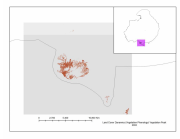Phenology
Type of resources
Available actions
Topics
Keywords
Contact for the resource
Provided by
Formats
Representation types
Update frequencies
status
-

The Land Cover Dynamics MODIS product is a yearly product that represents thetiming of vegetation phenology globally. Sub-datasets include vegetation growth, maturity,senescence, and dormancy. This product also includes the NBAR-(Nadir Bidirectionalreflectance distribution function (BRDF) adjusted Reflectance) based EVI, in part becausethe EVI is used to create the Land Cover Dynamics. The Land Cover Dynamics product uses both Terra and Aqua MODIS data. Version005 (provided) has a 500 m spatial resolution, which is an improvement from the 1,000 mversion 004 product. This product is only available in MODIS tiles, so the tiles needed tocover the CAFF pan-Arctic region has been downloaded but not clipped to the pan-Arcticextent at this time.
-
Sexual reproduction is critical to the resilience of seagrass beds impacted by habitat degradation or environmental changes, as robust seed banks allow new shoots to establish each year. Reproductive strategies of seagrass beds range on a continuum from strictly annual to perennial, driven by local environmental conditions. We examined the reproductive dynamics of Zostera marina beds at six sites on the Atlantic coast of Canada to characterize how life history strategies are shaped by the surrounding environment. Sites were categorized as wave protected and wave exposed, where protected sites were warm, shallow, with little water movement and muddy sediments, and exposed sites were either shallow or deep, with cooler water and sandy sediments. While mixed life history strategies were evident at all sites, protected eelgrass beds exhibited both the highest and lowest sexual reproductive effort relative to exposed beds. These beds regularly experienced thermal stress, with higher temperature range and extended warm water events relative to exposed beds. The development of reproductive shoots were similar across sites with comparable Growing Degree-days at the beginning and end of anthesis, but the First Flowering Date was earlier at the protected warmer sites relative to exposed sites. With different reproductive shoot density among sites, seed production, seed retention, and seedling recruitment also varied strongly. Only one site, located in a warm, shallow and protected lagoon, contained a mixed life history population with a high reproductive effort (33.7%), strong seed bank, and high seedling establishment. However, a primarily perennial population with the lowest reproductive effort (0.5%) was identified at the warmest site, suggesting that conditions here could not support high sexual reproduction. Robustness of seed banks was strongly linked to reproductive shoot density, although the role of seed retention, germination and seedling survival require further investigation. Our study provides insights into one key aspect of seagrass resilience, and suggests that resilience assessments should include reproductive shoot density to inform their management and conservation. Cite this data: Vercaemer B. and Wong M. Reproductive ecology of Zostera marina L. (eelgrass) across varying environmental conditions. Published: May 2022. Coastal Ecosystems Science Division, Fisheries and Oceans Canada, Dartmouth, N.S. https://open.canada.ca/data/en/dataset/56cfea6f-aeca-47ed-94ab-c519d9e63c91
 Arctic SDI catalogue
Arctic SDI catalogue